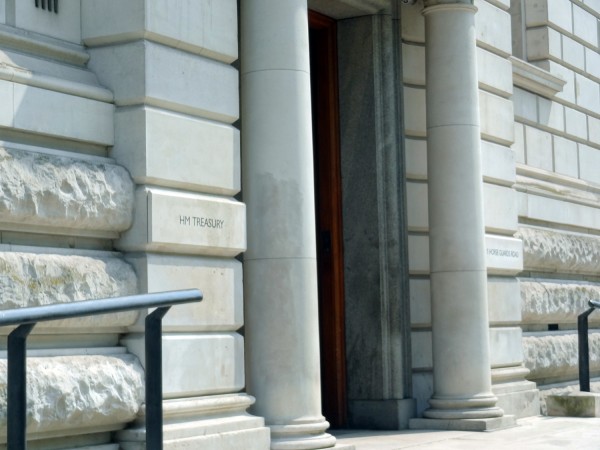 In delivering his Budget on 22 November, Philip Hammond reported that the independent Office for Budget Responsibility had revised down its forecasts of growth in productivity and real GDP, and hence of earnings growth.
In delivering his Budget on 22 November, Philip Hammond reported that the independent Office for Budget Responsibility had revised down its forecasts of growth in productivity and real GDP, and hence of earnings growth.
Today, median earnings are £23,000 per annum. This is £1500 less than the £24,500 that the median worker earned in 2008 in today’s prices. The OBR forecasts a growth in real household disposable income of just 0.35% per annum for the next four years.
With lower growth in earnings would come a lower growth in tax revenues. With his desire to cut the budget deficit and start eventually reducing government debt, this would give the government less scope for spending on infrastructure, training and other public-sector investment; less scope to support public services, such as health and education; less scope for increasing benefits and public-sector wages.
The normal measure of productivity, and the one used by the OBR, is the value of output produced per hour worked. This has hardly increased at all since the financial crisis of 2008. It now takes an average worker in the UK approximately five days to produce the same amount as it takes an average worker in Germany four days.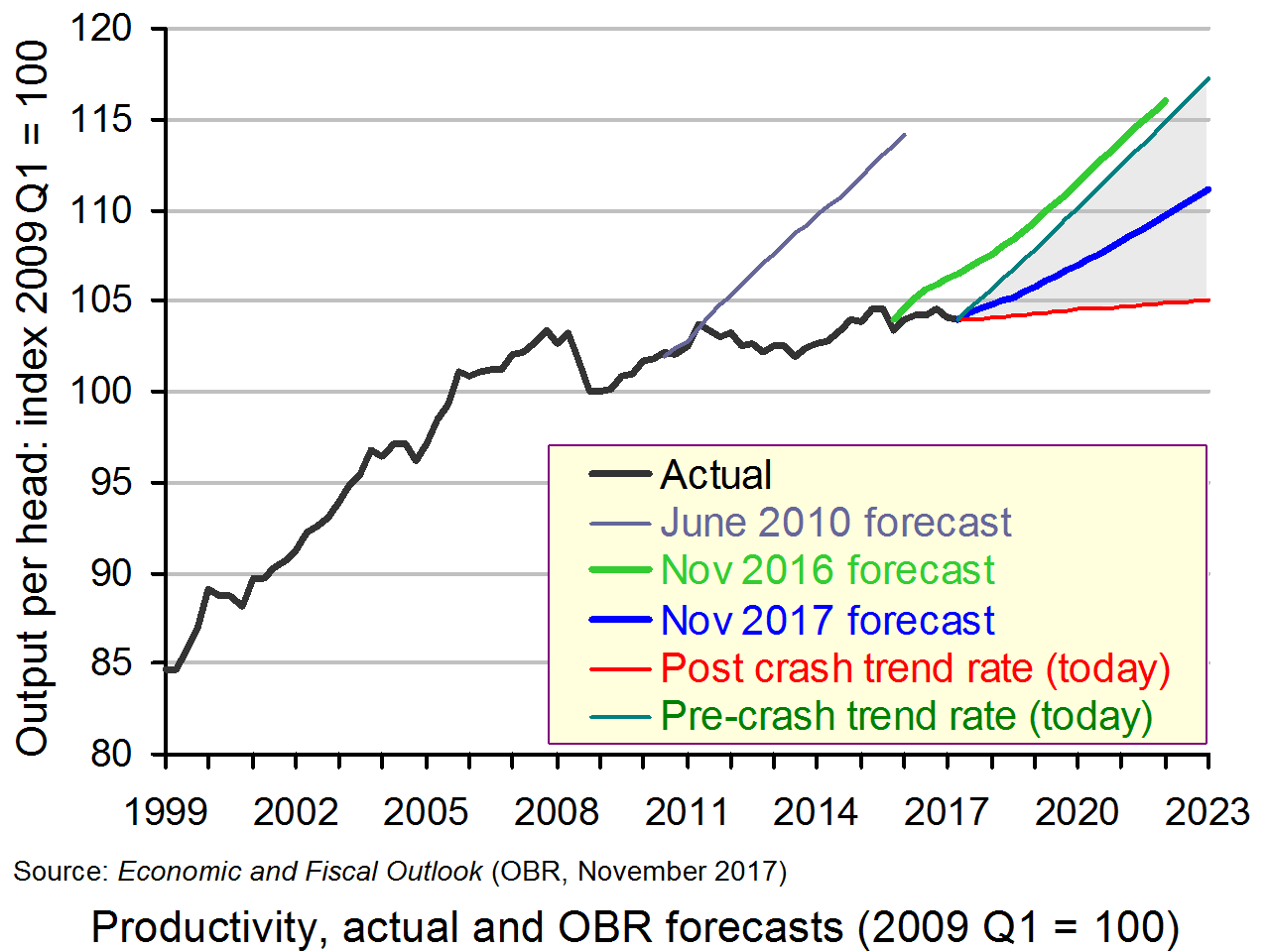 Although other countries’ productivity growth has also slowed since the financial crisis, it has slowed more in the UK and from a lower base – and is now forecast to rebound less quickly.
Although other countries’ productivity growth has also slowed since the financial crisis, it has slowed more in the UK and from a lower base – and is now forecast to rebound less quickly.
For the past few years the OBR has been forecasting that productivity growth would return to the trend rate of just over 2% that the UK achieved prior to 2008. For example, the forecasts it made in June 2010 are shown by the grey line in the chart, which were based on the pre-crash trend rate of growth in productivity (click on chart to enlarge). And the forecasts it made in November 2016 are shown by the pale green line. Yet each year productivity has hardly changed at all. Today output per hour is less than 1% above its level in 2008.
Now the OBR believes that poorer productivity growth will persist. It is still forecasting an increase (the blue line in the chart) – but by 0.7 of a percentage point less than it was forecasting a year ago (the pale green line): click here for a PowerPoint of the chart.
We have assumed that productivity growth will pick up a little, but remain significantly lower than its pre-crisis trend rate throughout the next five years. On average, we have revised trend productivity growth down by 0.7 percentage points a year. It now rises from 0.9 per cent this year to 1.2 per cent in 2022. This reduces potential output in 2021-22 by 3.0 per cent. The ONS estimates that output per hour is currently 21 per cent below an extrapolation of its pre-crisis trend. By the beginning of 2023 we expect this to have risen to 27 per cent.
Why has there been such weak productivity growth?
Weak productivity growth has been caused by a mixture of factors.
Perhaps the most important is that investment as a percentage of GDP has been lower than before the financial crisis and lower than in other countries. Partly this has been caused by a lack of funding for investment as banks have sought to rebuild their capital and have cut down on riskier loans. Partly it has been caused by a lack of demand for investment, given sluggish rates of economic growth and the belief that austerity will continue.

And it is not just private investment. Public-sector investment in transport infrastructure, housing and education and training has been lower than in other countries. Indeed, the poor training record and low skill levels in the UK are main contributors to low productivity.
The fall in the pound since the Brexit vote has raised business costs and further dampened demand as incomes have been squeezed.
Another reason for low productivity growth has been that employers have responded to weak demand, not by laying off workers and thereby raising unemployment, but by retaining low-productivity workers on low wages. Another has been the survival of ‘zombie’ firms, which, by paying low wages and facing ultra-low interest rates, are able to survive competition from firms that do invest.
Why is weak productivity growth forecast to continue?
 Looking forward, the nature of the Brexit deal will impact on confidence, investment, wages and growth. If the deal is bad for the UK, the OBR’s forecasts are likely to be too optimistic. As it is, uncertainty over the nature of the post-Brexit world is weighing heavily on investment as some businesses choose to wait before committing to new investment.
Looking forward, the nature of the Brexit deal will impact on confidence, investment, wages and growth. If the deal is bad for the UK, the OBR’s forecasts are likely to be too optimistic. As it is, uncertainty over the nature of the post-Brexit world is weighing heavily on investment as some businesses choose to wait before committing to new investment.
On the other hand, exports may rise faster as firms respond to the depreciation of the pound and this may stimulate investment, thereby boosting productivity.
Another factor is the effect of continuing tight Budgets. There was some easing of austerity in this Budget, as the Chancellor accepted a slower reduction in the deficit, but government spending will remain tight and this is likely to weigh on growth and investment and hence productivity.
But this may all be too gloomy. It is very difficult to forecast productivity growth, especially as it is hard to measure output in much of the service sector. It may be that the productivity growth forecasts will be revised up before too long. For example, the benefits from new technologies, such as AI, may flow through more quickly than anticipated. But they may flow through more slowly and the productivity forecasts may have to be revised down even further!
Articles
The OBR’s productivity “forecast” Financial Times, Kadhim Shubber
U.K. Faces Longest Fall in Living Standards on Record Bloomberg, Simon Kennedy and Thomas Penny (23/11/17)
Britain’s Productivity Pain Costs Hammond $120 Billion Bloomberg, Fergal O’Brien (22/11/17)
OBR slashes Britain’s growth forecast on sluggish productivity and miserly pay The Telegraph, Tim Wallace (22/11/17)
Budget 2017: Stagnant earnings forecast ‘astonishing’ BBC News (23/11/17)
Economists warn Budget measures to lift productivity fall short Financial Times, Gavin Jackson and Gill Plimmer (22/11/17)
Why the economic forecasts for Britain are so apocalyptic – and how much Brexit is to blame Independent, Ben Chu (24/11/17)
Growth holds steady as economists doubt OBR’s gloom The Telegraph, Tim Wallace (23/11/17)
Britain’s debt will not fall to 2008 levels until 2060s, IFS says in startling warning Independent, Lizzy Buchan (23/11/17)
Philip Hammond’s budget spots Britain’s problems but fails to fix them The Economist (22/11/17)
Debunking the UK’s productivity problem The Conversation, Paul Lewis (24/11/17)
Budget 2017: experts respond The Conversation (22/11/17)
Autumn Budget 2017 Forecasts Mean ‘Longest Ever Fall In Living Standards’, Says Resolution Foundation Huffington Post, Jack Sommers (23/11/17)
It May Just Sound Like A Statistic, But Productivity Growth Matters For All Of Us Huffington Post, Thomas Pope (24/11/17) (see also)
UK prospects for growth far weaker than first predicted, says OBR The Guardian, Angela Monaghan (22/11/17)
UK faces two decades of no earnings growth and more austerity, says IFS The Guardian, Phillip Inman (23/11/17)
Age of austerity isn’t over yet, says IFS budget analysis The Guardian, Larry Elliott (23/11/17)
Summary of Budget measures
Budget 2017: FT experts look at what it means for you Financial Times (24/11/17)
Official Documents
Autumn Budget 2017 HM Treasury (22/11/17)
Economic and fiscal outlook – November 2017 Office for Budget Responsibility (22/11/17)
IFS analysis
 Autumn Budget 2017 Institute for Fiscal Studies (23/11/17)
Autumn Budget 2017 Institute for Fiscal Studies (23/11/17)
Questions
- What measures of productivity are there other than output per hour? Why is output per hour normally the preferred measure of productivity?
- What factors determine output per hour?
- Why have forecasts of productivity growth rates been revised downwards?
- What are the implications of lower productivity growth for government finances?
- What could cause an increase in output per hour? Would there be any negative effects from these causes?
- What policies could the government pursue to increase productivity? How feasible are these policies? Explain.
- Would it matter if the government increased borrowing substantially to fund a large programme of public investment?
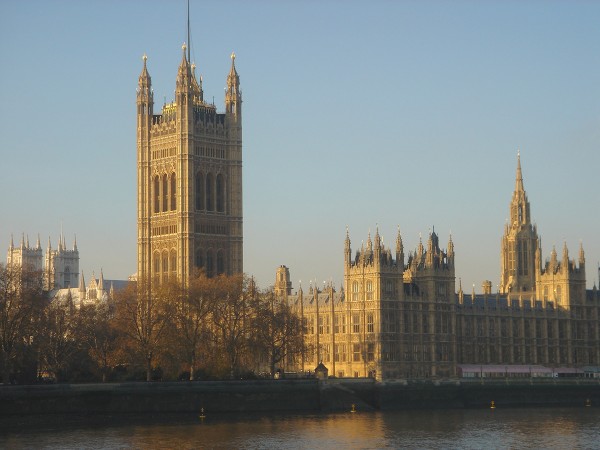 In his 2016 Autumn Statement, the new Chancellor of the Exchequer, Philip Hammond, announced that he was abandoning his predecessor’s target of achieving a budget surplus in 2019/20 and beyond. This was partly in recognition that tax revenues were likely to be down as economic growth forecasts were downgraded by the Office for Budget Responsibility. But it was partly to give himself more room to boost the economy in response to lower economic growth. In other words, he was moving from a strictly rules-based fiscal policy to one that is more interventionist.
In his 2016 Autumn Statement, the new Chancellor of the Exchequer, Philip Hammond, announced that he was abandoning his predecessor’s target of achieving a budget surplus in 2019/20 and beyond. This was partly in recognition that tax revenues were likely to be down as economic growth forecasts were downgraded by the Office for Budget Responsibility. But it was partly to give himself more room to boost the economy in response to lower economic growth. In other words, he was moving from a strictly rules-based fiscal policy to one that is more interventionist.
Although he still has the broad target of reducing government borrowing over the longer term, this new flexibility allowed him to announce increased government spending on infrastructure.
The new approach is outlined in the updated version of the Charter for Budget
Responsibility, published alongside the Autumn Statement. The government’s fiscal mandate would now include the following:
|
|
| • |
a target to reduce cyclically-adjusted public-sector net borrowing to below 2% of GDP by 2020/21; |
| • |
a target for public-sector net debt as a percentage of GDP to be falling in 2020/21. |
It also states that:
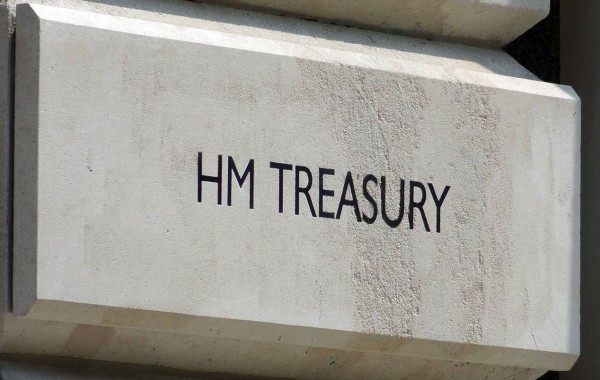 In the event of a significant negative shock to the UK economy, the Treasury will review the appropriateness of the fiscal mandate and supplementary targets as a means of returning the public finances to balance as early as possible in the next Parliament.
In the event of a significant negative shock to the UK economy, the Treasury will review the appropriateness of the fiscal mandate and supplementary targets as a means of returning the public finances to balance as early as possible in the next Parliament.
In the Autumn Statement, the new approach to fiscal policy is summarised as follows:
This new fiscal framework ensures the public finances continue on the path to sustainability, while providing the flexibility needed to support the economy in the near term.
With his new found freedom, the Chancellor was able to announce spending increases, despite deteriorating public finances, of £36bn by 2021/22 (see Table 1 in the Autumn Statement).
Most of the additional expenditure will be on infrastructure. To facilitate this, the government will set up a new National Productivity Investment Fund (NPIF)  to channel government spending to various infrastructure projects in the fields of housing, transport, telecoms and research and development. The NPIF will provide £23bn to such projects between 2017/18 and 2021/22.
to channel government spending to various infrastructure projects in the fields of housing, transport, telecoms and research and development. The NPIF will provide £23bn to such projects between 2017/18 and 2021/22.
But much of the additional flexibility in the new Fiscal Mandate will be to allow automatic fiscal stabilisers to operate. The OBR forecasts an increase in borrowing of £122bn over the 2017/18 to 2021/22 period compared with its forecasts made in March this year. Apart from the additional £23bn spending on infrastructure, most of the rest will be as a result of lower tax receipts from lower economic growth. This, in turn, is forecast to be the result of lower investment caused by Brexit uncertainties and lower real consumer spending because of the fall in the pound and the consequent rise in prices.
But rather than having to tighten fiscal policy to meet the previous borrowing target, the new Fiscal Mandate will permit this rise in borrowing. The lower tax payments will help to reduce the dampening effect on the economy.
So are we entering a new era of fiscal policy? Is the government now using discretionary fiscal policy to boost aggregate demand, while also attempting to increase productivity? Or is the relaxation of the Fiscal Mandate just a redrawing of the rules to give a bit more flexibility over the level of stimulus the government can give the economy?
Videos
 Autumn Statement 2016: Philip Hammond’s speech (in full) GOV.UK (23/11/16)
Autumn Statement 2016: Philip Hammond’s speech (in full) GOV.UK (23/11/16)
 Philip Hammond’s autumn statement – video highlights The Guardian (23/11/16)
Philip Hammond’s autumn statement – video highlights The Guardian (23/11/16)
 Key points from the chancellor’s first Autumn Statement BBC News, Andrew Neil (23/11/16)
Key points from the chancellor’s first Autumn Statement BBC News, Andrew Neil (23/11/16)
 Autumn Statement: higher borrowing, lower growth Channel 4 News, Helia Ebrahimi (23/11/16)
Autumn Statement: higher borrowing, lower growth Channel 4 News, Helia Ebrahimi (23/11/16)
 Autumn Statement: Chancellor’s growth and borrowing figures BBC News (23/11/16)
Autumn Statement: Chancellor’s growth and borrowing figures BBC News (23/11/16)
 Markets react to Autumn Statement Financial Times on YouTube, Roger Blitz (23/11/16)
Markets react to Autumn Statement Financial Times on YouTube, Roger Blitz (23/11/16)
 Hammond’s Autumn Statement unpicked Financial Times on YouTube, Gemma Tetlow (23/11/16)
Hammond’s Autumn Statement unpicked Financial Times on YouTube, Gemma Tetlow (23/11/16)
 Autumn Statement 2016: The charts that show the cost of Brexit Sjy News, Ed Conway (24/11/16)
Autumn Statement 2016: The charts that show the cost of Brexit Sjy News, Ed Conway (24/11/16)
 BBC economics editor Kamal Ahmed on the Autumn Statement. BBC News (23/11/16)
BBC economics editor Kamal Ahmed on the Autumn Statement. BBC News (23/11/16)
 Autumn statement: debate Channel 4 News, Financial Secretary to the Treasury, Jane Ellison, and Labour’s Shadow Business Secretary, Clive Lewis (23/11/16)
Autumn statement: debate Channel 4 News, Financial Secretary to the Treasury, Jane Ellison, and Labour’s Shadow Business Secretary, Clive Lewis (23/11/16)
 Autumn Statement: Workers’ pay growth prospects dreadful, says IFS BBC News, Kevin Peachey and Paul Johnson (24/11/16)
Autumn Statement: Workers’ pay growth prospects dreadful, says IFS BBC News, Kevin Peachey and Paul Johnson (24/11/16)
Articles
Autumn Statement 2016: Expert comment on fiscal policy Grant Thornton, Adam Jackson (23/11/16)
Philip Hammond loosens George Osborne’s fiscal rules to give himself more elbow room as Brexit unfolds CityA.M., Jasper Jolly (23/11/16)
Britain’s New Fiscal Mandate Opens Way To Invest For Economic Growth Forbes, Linda Yueh (23/11/16)
Autumn Statement 2016: experts respond The Conversation (23/11/16)
Chancellor’s ‘Reset’ Leaves UK Economy Exposed And Vulnerable Huffington Post, Alfie Stirling (23/11/16)
Britain’s Autumn Statement hints at how painful Brexit is going to be The Economist (26/11/16)
Chancellor’s looser finance targets highlight weaker UK economy The Guardian, Phillip Inman (24/11/16)
Hammond’s less-than-meets-the-eye plan that hints at the future Financial Times, Martin Sandbu (23/11/16)
Economists’ views on Philip Hammond’s debut Financial Times, Paul Johnson, Bronwyn Curtis and Gerard Lyons (24/11/16)
Government Publications
Autumn Statement 2016 HM Treasury (23/11/16)
Charter for Budget Responsibility: autumn 2016 update HM Treasury
Reports, forecasts and analysis
Economic and fiscal outlook – November 2016 Office for Budget Responsibility (23/11/16)
Autumn Statement 2016 analysis Institute for Fiscal Studies (November 2016)
Questions
- Distinguish between discretionary fiscal policy and rules-based fiscal policy.
- Why have forecasts of the public finances worsened since last March?
- What is meant by automatic fiscal stabilisers? How do they work when the economic growth slows?
- What determines the size of the multiplier from public-sector infrastructure projects?
- What dangers are there in relaxing the borrowing rules in the Fiscal Mandate?
- Examine the arguments for relaxing the borrowing rules more than they have been?
- If the economy slows more than has been forecast and public-sector borrowing rises faster, does the Chancellor have any more discretion in giving a further fiscal boost to the economy?
- Does the adjustment of borrowing targets as the economic situation changes make such a policy a discretionary one rather than a rules-based one?
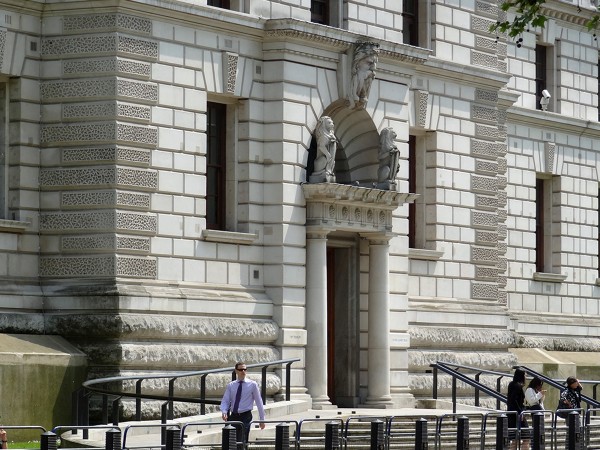 As the Chancellor of the Exchequer, Philip Hammond, delivers his first Autumn statement, both the Office for Budget Responsibility (OBR) and the National Institute for Economic and Social Research (NIESR) have published updated forecasts for government borrowing and government debt.
As the Chancellor of the Exchequer, Philip Hammond, delivers his first Autumn statement, both the Office for Budget Responsibility (OBR) and the National Institute for Economic and Social Research (NIESR) have published updated forecasts for government borrowing and government debt.
They show a rise in government borrowing compared with previous forecasts. The main reason for this is a likely slowdown in the rate of economic growth and hence in tax revenues, especially in 2017. Last March, the OBR forecast GDP growth of 2.2% for 2017; it has now revised this down to 1.4%.
This forecast slowdown is because of a likely decline in the growth of aggregate demand caused by a decline in investment as businesses become more cautious given the uncertainty about the UK’s relationships with the rest of the world post Brexit. There is also likely to be a slowdown in real consumer expenditure as inflation rises following the fall in the pound of around 15%.
But what might be more surprising is that the public finances are not forecast to deteriorate even further. The OBR forecasts that the deficit will increase by a total of £122bn to £216bn over the period from 2016/17 to 2020/21. The NIESR predicts that it will rise by only £50bn to £187bn – but this is before the additional infrastructure spending and other measures announced in the Autumn Statement.
 One reason is looser monetary policy. Following the Brexit vote, the Bank of England cut Bank Rate from 0.5% to 0.25% and introduced further quantitative easing. This makes it cheaper to finance government borrowing. What is more, the additional holdings of bonds by the Bank mean that the Bank returns to the government much of the interest (coupon payments) that would otherwise have been paid to the private sector.
One reason is looser monetary policy. Following the Brexit vote, the Bank of England cut Bank Rate from 0.5% to 0.25% and introduced further quantitative easing. This makes it cheaper to finance government borrowing. What is more, the additional holdings of bonds by the Bank mean that the Bank returns to the government much of the interest (coupon payments) that would otherwise have been paid to the private sector.
Then, depending on the nature of the UK’s post-Brexit relationships with the EU, there could be savings in contributions to the EU budget – but just how much, no-one knows at this stage.
Finally, it depends on just what effects the measures announced in the Autumn Statement will have on tax revenues and government spending. We will examine this in a separate blog.
But even though public-sector borrowing is likely to fall more slowly than before the Brexit vote, the trajectory is still downward. Indeed, the previous Chancellor, George Osborne, had set a target of achieving a public-sector surplus by 2019/20.
But, would eventually bringing the public finances into surplus be desirable? Apart from the dampening effect on aggregate demand, such a policy could lead to underinvestment in infrastructure and other public-sector capital. There is thus a strong argument for continuing to run a deficit on the public-sector capital account to fund public-sector investment – such investment will increase incomes and social wellbeing in the future. It makes sense for the government to borrow for investment, just as it makes sense for the private sector to do so.
Articles
Autumn Statement: Why the damage to the public finances from Brexit might not be as bad as some think Independent, Simon Kirby (22/11/16)
Three Facts about Debt and Deficits NIESR blogs, R Farmer (21/11/16)
Autumn Statement: Big increase in borrowing predicted BBC News, Anthony Reuben (23/11/16)
Data
Economic and fiscal outlook – November 2016 Office for Budget Responsibility (23/11/16)
Questions
- Why have the public finances deteriorated?
- How much have they deteriorated?
- What is likely to happen to economic growth over the next couple of years? Explain why.
- How has the cut in Bank Rate and additional quantitative easing introduced after the Brexit vote affected government borrowing?
- What is likely to happen to (a) public-sector borrowing; (b) public-sector debt as a proportion of GDP over the next few years?
- Why is a running a Budget surplus neither a necessary nor a sufficient condition for reducing the government debt to GDP ratio.
- What are the arguments for (a) having a positive public-sector debt; (b) increasing public-sector debt as a result of increased spending on infrastructure and other forms of public-sector capital?
 The UK has always been an attractive place for investment, as foreign companies look to cities such as London for stable investment opportunities. This provides not only jobs and output, but also tax revenue for the government. However, one drawback is the lost tax revenue through tax avoidance schemes and big businesses say that if the UK is to remain competitive it needs to look at cutting taxes and bureaucracy.
The UK has always been an attractive place for investment, as foreign companies look to cities such as London for stable investment opportunities. This provides not only jobs and output, but also tax revenue for the government. However, one drawback is the lost tax revenue through tax avoidance schemes and big businesses say that if the UK is to remain competitive it needs to look at cutting taxes and bureaucracy.
In recent months, we have seen cases of individuals being prosecuted for tax evasion and more recently in the USA, Microsoft and Hewlett-Packard have been criticized by the Senate for allegedly moving an estimated £13bn to offshore accounts. (Microsoft and HP deny any wrong-doing). It is cases like this that provide an argument for governments to cut business rates and avoid losing business and jobs to other tax havens. Lord Fink, who is a Director of Firms located in a variety of tax havens said:
’I don’t see why the UK should not compete for jobs that at present are going to the Cayman Islands’
 Tax havens are obviously attractive to firms, as they provide a means of retaining more of a firm’s earnings and hence their profits. By offering a much lower rate of tax than countries such as the UK, they help to ease the tax burden on wealthy individuals and investors in hedge funds, along with many others.
Tax havens are obviously attractive to firms, as they provide a means of retaining more of a firm’s earnings and hence their profits. By offering a much lower rate of tax than countries such as the UK, they help to ease the tax burden on wealthy individuals and investors in hedge funds, along with many others.
The question is, do these lower tax rates discourage investment into the UK and thus would a relaxation of Revenue Customs’ rules mean an increase in inward investment and the other positive things that this would bring? Or would a decrease in tax rates for wealthy investors send the wrong message?
 In a time of austerity, tax cuts for the rich are never going to be a popular policy – at least not amongst the ‘non-rich’ – in truth, the majority of the population. Furthermore, many simply see tax havens as morally wrong – or as George Osborne put it ‘morally repugnant’. The use of them provides the better off with a means of paying less to the taxman, whilst the worse off continue to pay their share.
In a time of austerity, tax cuts for the rich are never going to be a popular policy – at least not amongst the ‘non-rich’ – in truth, the majority of the population. Furthermore, many simply see tax havens as morally wrong – or as George Osborne put it ‘morally repugnant’. The use of them provides the better off with a means of paying less to the taxman, whilst the worse off continue to pay their share.
The controversy surrounding tax havens is perhaps even more of an issue given the size of the public-sector deficit. With tax havens being used by those who should be paying the most, tax revenues are lower than would be the case without tax evasion and avoidance. Is this adding to the burden of basic rate tax payers?
This doesn’t help the gap between government expenditure and revenue, which has contributed to the largest amount of UK public-sector borrowing in August 2012 since records began. Net borrowing reached £14.4bn, as things like corporation tax receipts fell and benefit payments rose. Money that should go in to the government’s coffers is undoubtedly making its way into tax havens, but does that also mean that jobs are making their way out of the country? If tax rates in the UK were cut, cities such as London may become even more attractive places to invest, which could potentially create a much needed boost for the economy. But, at what cost? The following articles consider the controversy of tax havens.
Microsoft and HP rapped by US Senate over tax havens BBC News (20/9/12)
Morally repugnant tax avoiders can rest easy under David Cameron Guardian, Tanya Gold (21/9/12)
Britain could prevent the use of tax havens by ending ‘archaic’ business rules Telegraph, Rowena Mason (21/9/12)
UK public-sector borrowing hits record high of £14.4bn BBC News (21/9/12)
The top Tory who wants to make Britain a tax haven for millionaires Guardian, Martin Williams and Rajeev Syal (20/9/12)
Make UK a tax haven to attract investment from millionaires, urges Tory treasurer Mail Online, Daniel Martin (21/9/12)
Microsoft saved billions using Irish tax havens Irish Times, Genevieve Carbery (21/9/12)
Microsoft, HP skirted taxes via offshore units: U.S. Senate Panel Reuters, Kim Dixon (21/9/12)
Danny Alexander says tax avoidance ‘adds 2p in every £1 to basic tax rate’ Independent, Oliver Wright (24/6/12)
Questions
- What are the key features of tax havens?
- Briefly explain the arguments in favour of tax havens and those against. Think about them from all points of view.
- Explain the way in which a cut in UK tax rates could create jobs and how the multiplier effect may provide a boost for the UK economy.
- If tax rates were cut, how might this affect an individual’s decision to work? What about an individual’s decision to invest? Use indifference analysis to help explain your answer.
- How does tax avoidance and evasion affect public sector borrowing? Is there any way a cut in tax rates on foreign investment could improve the government’s finances?
- Do you think there is any truth in the argument that the UK is losing out to other countries because of its higher tax rates? Is a reduction in tax rates necessary to help us compete?
 On 2 May 2012, Sir Mervyn King, Governor of the Bank of England, gave the BBC Today Prgramme’s public lecture. In it, he reflected on the causes and aftermath of the banking crisis of 2007/8.
On 2 May 2012, Sir Mervyn King, Governor of the Bank of England, gave the BBC Today Prgramme’s public lecture. In it, he reflected on the causes and aftermath of the banking crisis of 2007/8.
He said that the main cause of the banking crisis was the risky behaviour of the banks themselves – behaviour that they had been allowed to get away with becuase regulation was too light. The cause was not one of inappropriate fiscal and monetary policy.
According to Dr King, there had been no classical macroeconomic boom and bust. True there had been a bust, but there was no preceding boom. Economic growth had not been unsustainable in the sense of being persistently above the potential rate. In other words, the output gap had been close to zero. As Mervyn King puts it
Let me start by pointing out what did not go wrong. In the five years before the onset of the crisis, across the industrialised world growth was steady and both unemployment and inflation were low and stable. Whether in this country, the United States or Europe, there was no unsustainable boom like that seen in the 1980s; this was a bust without a boom.
In terms of monetary policy, inflation had been on track and interest rates were not too low. And as for fiscal policy, government borrowing had been within the Golden Rule, whereby, over the cycle, the goverment borrowed only to invest and kept a current budget balance. Indeed, the period of the late 1990s and early to mid 2000s had become known as the Great Moderation.
So what went wrong? Again in the words of Dr King:
In a nutshell, our banking and financial system overextended itself. That left it fragile and vulnerable to a sudden loss of confidence.
The most obvious symptom was that banks were lending too much. Strikingly, most of that increase in lending wasn’t to families or businesses, but to other parts of the financial system. To finance this, banks were borrowing large amounts themselves. And this was their Achilles’ heel. By the end of 2006, some banks had borrowed as much as £50 for every pound provided by their own shareholders. So even a small piece of bad news about the value of its assets would wipe out much of a bank’s capital, and leave depositors scurrying for the door. What made the situation worse was that the fortunes of banks had become closely tied together through transactions in complex and obscure financial instruments. So it was difficult to know which banks were safe and which weren’t. The result was an increasingly fragile banking system.
But doesn’t his imply that regulation of the banking system had failed? And if so why? And have things now been fixed – so that banks will no longer run the risk of failure? Dr King addresses this issue and others in his speech and also in his interview the next day for the Today Programme, also linked to below.
Podcasts
The Today Programme Lecture BBC Radio 4, Sir Mervyn King (2/5/12) (Transcript of speech)
Also on YouTube at Governor’s Today Programme lecture, 2 May 2012
Sir Mervyn King: The full interview BBC Today Programme, Sir Mervyn King talks to Evan Davis (3/5/12)
Sir Mervyn King analysis ‘verging on delusional’ BBC Today Programme, Dylan Grice and Ngaire Woods (3/5/12)
Articles
Sir Mervyn King rejects criticism for crisis BBC News (3/5/12)
The boom and bust of Mervyn King BBC News, Robert Peston (3/5/12)
Sir Mervyn King admits BoE failed over financial crisis The Telegraph, Philip Aldrick (3/5/12)
Sir Mervyn King admits: we did too little to warn of economic crisis Guardian, Larry Elliott (2/5/12)
King Says BOE Will Risk Unpopularity to Prevent Crises Bloomberg, Jennifer Ryan and Scott Hamilton (3/5/12)
Data
Economic Outlook Annex Tables OECD (See Annex Tables 1, 10, 14, 18, 27, 28, 32, 33, 61 and 62)
Statistical Interactive Database Bank of England (See for example, A Money and Lending: counterparts to changes in M4, alternative presentation > Seasonally adjusted > Public sector contribution > PSNCR)
Questions
- Why was the period of the late 1990s and early to mid 2000s described as the Great Moderation?
- Chart the size of the output gap, the rate of inflation and public-sector deficits as a percentage of GDP in the UK and other major economies from 1995 to 2007. Is this evidence of the Great Moderation?
- To what extent would evidence of house prices, consumer debt, bank lending and the balance of trade deficit suggest that there was indeed a boom from the mid 1990s to 2007?
- What, according to Dr King were the main causes of the credit crunch?
- What, with hindsight, should the Bank of England have done differently?
- What UK body was responsible for regulating banks in the run up to the credit crunch? Why might its regulation be described as ‘light touch’?
- In what sense was there a moral hazard in central banks being willing to bail out banks?
- What banking reforms have taken place or will take place in the near future? Will they address the problems identified by Dr King and prevent another banking crisis ever occurring again?
 In delivering his Budget on 22 November, Philip Hammond reported that the independent Office for Budget Responsibility had revised down its forecasts of growth in productivity and real GDP, and hence of earnings growth.
In delivering his Budget on 22 November, Philip Hammond reported that the independent Office for Budget Responsibility had revised down its forecasts of growth in productivity and real GDP, and hence of earnings growth. Although other countries’ productivity growth has also slowed since the financial crisis, it has slowed more in the UK and from a lower base – and is now forecast to rebound less quickly.
Although other countries’ productivity growth has also slowed since the financial crisis, it has slowed more in the UK and from a lower base – and is now forecast to rebound less quickly. Looking forward, the nature of the Brexit deal will impact on confidence, investment, wages and growth. If the deal is bad for the UK, the OBR’s forecasts are likely to be too optimistic. As it is, uncertainty over the nature of the post-Brexit world is weighing heavily on investment as some businesses choose to wait before committing to new investment.
Looking forward, the nature of the Brexit deal will impact on confidence, investment, wages and growth. If the deal is bad for the UK, the OBR’s forecasts are likely to be too optimistic. As it is, uncertainty over the nature of the post-Brexit world is weighing heavily on investment as some businesses choose to wait before committing to new investment. Autumn Budget 2017 Institute for Fiscal Studies (23/11/17)
Autumn Budget 2017 Institute for Fiscal Studies (23/11/17)








